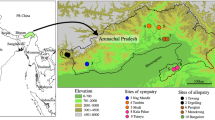Summary
A new ant speciesLasius (Lasius) neglectus spec. nov. is described from Budapest, Hungary. The workers are morphologically similar toL. alienus, but queens and males are clearly different and are much smaller. The species is polygynous, without apparent colony barriers, there are probably no nuptial flights, and intra-nidal mating has been observed; in this respectL. neglectus has several features in common with the polygynous Japanese speciesL. sakagamii. Workers forage in huge masses on aphids in tress. It is argued that the rather late discovery ofL. neglectus might be due to its arfificial introduction in Budapest from a yet unknown area. The status as a distinct species is further confirmed by allozyme data (Boomsma et al., 1990, next paper).
Resume
Une nouvelle espèce de fourmiLasius (Lasius) neglectus spec. nov. est écrite de Budapest, Hongrie. La morphologie des ouvrières ressemble à celle deL. alienus, mais les femelles et les mâles sont clairement distincts, avec des tailles plus petites. L'espèce est polygyne, sans frontières de nids évidentes, les vols nuptiaux semblent absents ou en tous cas rares et des accouplements entre partenaires d'un même nid ont été observés.L. neglectus ressemble par ces caractères à l'espèce polygyne japonaiseL. sakagamii. Les ouvrières recherchent en grand nombre les pucerons dans les arbres. Les auteurs postulent que la découverte récente deL. neglectus est peut-être due à son introduction artificielle à Budapest depuis une origine inconnue. Le statut spécifique de cette espèce est aussi confirmé par analye d'allozymes (Boomsma et al., 1990, article suivant).
Similar content being viewed by others
References
Agosti D., Collingwood C.A., 1987. — A provisional list of the Balkan ants (Hym. Formicidae) with a key to the worker caste. II. Key to the worker caste, including the European species without the Iberian.Mitt. Schw. Ent. Ges., 60, 261–293.
Bernard F., 1968. —Les Fourmis (Hymenoptera Formicidae)d'Europe occidentale et septentrionale. Faune d'Europe et du Bassin Méditerranéen, 3. Masson, Paris.
Boomsma J.J., Brouwer A.H., van Loon A.J., 1990. — A new polygynousLasius species (Hymenoptera; Formicidae) from central Europe. II. Allozymatic confirmation of the species status and social structure.Insectes Soc., 37, 363–375.
Emery C., 1869. — Enumerazione dei Formicidi che rinvengonsi nei contorni di Napoli.Ann. Acad. Asp. Natur. Napoli, 2, 1–27.
Keller L., Passera L., Submitted Ms. —Mating behaviour strategy of the Argentine ant Iridomyrmex humilis(Mayr): why do queens only seldom take part to a nuptial flight?
Kutter H., 1977. — Hymenoptera Formicidae.Insecta Helvetica, 6, Zürich.
Markin G.P., Dillier J.H., Hill S.O., Blum M.S., Hermann H.R., 1971. —Nuptial flight and flight ranges of the imported fire ant,Solenopsis saevissima richteri (Hymenoptera: Formicidae).J. Georgia Entomol., 6, 145–156.
Santschi F., 1921. — Nouvelles fourmis paléarctiques.Bol. Soc. Esp. Hist. Nat., 21, 165–170.
Sokal R.R., Rohlf F.J., 1981. —Biometry, 2nd ed. W.H. Freeman, San Francisco.
Starcke A., 1944. — Retouches sur quelques Fourmis d'Europe. III. AutresLasius.Ent. Ber., 11, 153–158.
Stitz H., 1939. — Die Tierwelt Deutschlands, 37. Hautflügler oder Hymenoptera I:Ameisen oder Formicidae. Jena.
Wilson E.O., 1955. — A monographic revision of the ant genusLasius.Bull. Mus. Comp. Zool., Harvard Coll., 113, 1–199.
Yamauchi K., Hayashida K., 1970. — Taxonomic studies on the genusLasius in Hokkaido, with ethological and ecological notes (Formicidae, Hymenoptera). II. The subgenusLasius.Journ. Fac. Sci., Hokkaido Univ., Ser. VI, Zool., 17, 510–519.
Yamauchi K., Kinomura K., Miyake S., 1981. — Sociobiological studies of the polygynic antLasius sakagamii. I. General features of its polydomous system.Insectes soc., 28, 279–296.
Zimmermann S., 1934. — Beitrag zur Kenntnis der Ameisenfauna Süddalmatiens.Verh. Zool. Bot. Ges. Wien, 84, 1–65.
Author information
Authors and Affiliations
Rights and permissions
About this article
Cite this article
Van Loon, A.J., Boomsma, J.J. & Andrasfalvy, A. A new polygynousLasius species (Hymenoptera; Formicidae) from central Europe. Ins. Soc 37, 348–362 (1990). https://doi.org/10.1007/BF02225997
Received:
Accepted:
Issue Date:
DOI: https://doi.org/10.1007/BF02225997




